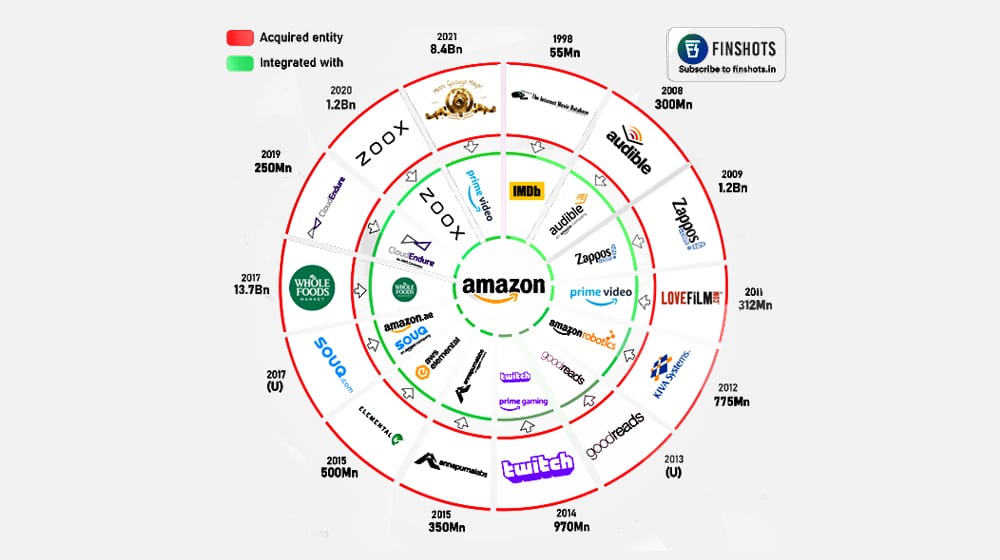What's The Difference Between Vertical and Horizontal Growth?

In business, growing your company is the goal of nearly every action you take. The thing is, there's more to growth than "grow the business." For example, how does the business grow? Does it grow horizontally or vertically?
Today I'll discuss what those growth strategies mean for entrepreneurs, the key differences, and which is better, if either.
Let's get started!
 30 Second Summary
30 Second Summary
You can grow your business in two main ways: vertical or horizontal growth. Vertical growth means you expand within your current market by adding related products or features. You'll have less risk since you know your industry well, but your growth potential is limited. Horizontal growth means you branch into new markets entirely - like how Amazon went from books to everything else. You'll get bigger opportunities but have more risk and competition since you're entering unfamiliar territory.
What is Vertical Growth?
When considering an expansion strategy, you're often thinking of vertical growth.
For example, an auto manufacturer might specialize in luxury sedans. They make excellent cars, and that's it. Eventually, they reach a peak in business; they can't sell more cars yearly because they've saturated their market. There aren't that many more people entering the market to capture. To keep growing as an auto-maker, they need to expand its offerings.

So, they might:
- Develop a luxury SUV.
- Develop a sports car.
- Develop a budget offering.
- Develop a utility truck.
Each is a way to expand within the vertical vehicle sales industry. They're adjacent markets, so the business already has some expertise and reputation that they can leverage to break into that new target audience.
Sometimes this works exceptionally well. A luxury vehicle maker expanding into luxury SUVs helps bring that luxury to people with more significant capacity requirements than a sedan can provide. For example, Cadillac primarily made luxury cars but eventually released an SUV in the form of the Escalade. It serves a different market but still carries the panache and reputation of Cadillac with it.
Vertical growth within something like software is a little trickier. Usually, it means expanding the current products you have on offer. A company like Ahrefs, which started as a backlink tracker, has since added features for rank tracking, keyword exploring, site analysis, and more.

Those are still SEO/Marketing/Website tools, so they're still within the same vertical.
Vertical growth has a few tangible benefits. For one thing, since you're already intimately familiar with the market, you don't need to do a ton of research to grow. You already know your industry and its demographics and biases, your competition, and the kinds of challenges you're likely to face. You may even be able to read case studies of other companies similar to yours who made the same jump.
On the other hand, vertical growth can be challenging to achieve. You need to know how to expand and be able to invest in new offerings that are adjacent to your own but beneficial enough to attract a new audience. Adding a new feature isn't necessarily vertical growth, but it expands your existing presence. You may also encounter workforce issues.
What is Horizontal Growth?
Horizontal growth is a little different.
A few examples of horizontal integration might include:
- Amazon started as a bookstore but eventually expanded into electronics and household goods. Today, they have a market share in pretty much everything, from grocery shopping and data center services to delivery and smart home products. Technically some of these additions are still within the "niche" of online commerce, but it's more of an example of horizontal growth.
- Uber is an example of a company using vertical growth as well; UberX is an alternate Uber for cheaper rides. Uber started as a taxi service via ride-sharing but has since expanded into food delivery with UberEats. Likewise, their attempt to develop self-driving cars is another example of horizontal expansion.
Where you draw the line is often a matter of perspective. Horizontal growth may feel like vertical growth, depending on how closely related the new market is to the old market. Every new offering that Uber adds could be considered vertical growth as long as they're dealing with cars, for example. It would be vertical growth if they started selling eBikes or trying to offer rideshares in Cessnas.

Horizontal growth has the most significant potential for benefit. Breaking into an entirely new market, new demographic, and new product, all of it at once, has the potential to be an incredible success. In some cases, the success of this new market power can even eclipse the old offering entirely.
Take the video game Fortnite for example. It started as a mediocre base-building and horde-defense mode that people didn't care about. Epic, developers of Fortnite, quickly focused their efforts on the battle royale game, leaving the defense mode behind. Then they added the player-versus-player, 100-person battle royale mode, and the game became a smash hit, defining an entire genre.
Sometimes, horizontal growth fails not because of any fault of your own but because of competition that outdoes you. For example, HD-DVD and Blu-Ray were released around the same time, and it became a battle of adoption to see which one would take over. HD-DVD wasn't necessarily worse than Blu-Ray; many argue that it was better for various reasons, but it didn't win popular support, so it didn't take over. Similarly, the fight between the Barnes and Noble Nook, the Amazon Kindle, or the Microsoft Zune versus the Apple iPod.

Sometimes, horizontal growth is poorly timed. Apple's Newton PDA was a tablet before tablets were popular. That product is considered a flop, even though similar technology is now commonplace and dominated by Apple with the iPad.
Growth Strategies for Various Business Types
You have to nail the right strategy if you want to win in business, right? If you're a startup, a SaaS platform, an e-commerce company, or a social media enterprise, you need a plan shaped for your unique needs. And it's a tough call choosing between growth going upwards (vertical) or expanding outwards (horizontal).
It can make a big difference to how your business moves each day, right through to your long-term wins and your spot in the market.

Your type of business and the stage you're at in your business will also influence this decision:
- What makes a startup succeed? One really important is picking out what you do best and really going for it. Building on these standout abilities can keep you competitive and your business strategy well-rounded with both vertical and horizontal growth. It helps widen your reach into new, profitable areas. Keep your audience engaged across different channels. Professional networking on LinkedIn is one technique; positioning yourself as a thought leader through podcasts is another, and who can forget about the large reach social media gives you? Start with this before you worry too much about horizontal or vertical growth.
- What about e-commerce? You'd better be ready for the speed and competitiveness of the online retail world, where what customers want and what's trending keep shifting. In a nutshell, going vertical - like growing your product lineup or boosting your service offerings within your existing market - can bring you closer to your customers and keep them loyal. At the same time, going horizontal unlocks different market segments or different products, which can be helpful to add fresh sources of earnings and reducing your risk of market saturation.
- SaaS companies have a two-fold challenge on their hands. It's not easy to keep the spirit of innovation alive while also driving growth, and thinking vertically to better-existing functionalities or adding more features could lift value for your customers, locking in more of them, which improves your long-term ROI over time. The horizontal play - crossing into new sectors or launching other product lines - opens up possibilities for scaling up and diversifying your earnings. That's super useful for long-term balance.
- Professional service businesses flourish when they primarily stick to what they're best at, and vertical growth opportunities are usually the best fit. If they concentrate on this, and tune their growth strategies to what their customers want, it could lead to a huge boost in their career and make their clients really happy. It's important to have a plan for step-by-step growth, like finding ways to make their services even better or offering more of them. Don't forget the importance of your marketing strategy, too!
- Brick-and-mortar shop owners fuel their growth with a mix of both strategies - vertical and horizontal. How do they boost their vertical growth in the market they already have? That's pretty simple! They up their game in shop experiences or offer products you can't find anywhere else. Let's not forget how this can grow customer loyalty and improve business operations, both of which can really boost returns in the long run. Horizontal growth may be adding an online shop and exploring new market segments to seek more chances for growth. A two-pronged strategy can be a great way to stay competitive.
Whatever your line of business is, you have to plan strategically. A thorough analysis of potential growth paths, knowing what you're already good at, and getting a grip on the market scenario is part of the process. If you're looking to go farther - maybe by adding your supply chain vertically or pushing into new markets horizontally - you need to back up your plan with effective marketing and stay on top of your operational game.
Remember, a simple, one-size-fits-all approach isn't going to work when it comes to growing your business. Every company needs a tailored strategy that syncs with its own market position, what it can do, and what it's planning for the future.
Let's look at our company as an example (Content Powered). When we first launched our agency, all we offered was our blog management service.

A few years later, we now also offer media mention link building and Google Ad management services. This has helped us earn larger clients, but also attract clients who didn't necessarily need content management but needed those other things.

This is a good example of vertical growth.
Horizontal vs. Vertical Growth: Which is Best?
Which is better: horizontal or vertical growth?
Generally, companies focus on vertical growth as much as possible because it's easier. Horizontal growth has more potential for success but requires more investment and risk, so it's usually much more carefully considered.
There's also another avenue for horizontal growth. You see it with Google; instead of developing a new product, wait until someone else does it and is starting to grow, and then buy them. Google also has their share of failed and dead services. Note, though, that this can more accurately be considered integration rather than growth, which I'll discuss later.

Many of Google's best, most enduring products were properties they purchased.
- YouTube was a stand-alone video site before Google bought it.
- DoubleClick was a primary competitor for Google's then-fledgling ad networks when they acquired it.
- Android was a stand-alone operating system for mobile phones before Google bought it.
- Google's link tracking UTM parameters came from another company they purchased.
- Many of the valuable features of Google Maps came from Waze.
Much of Google's core search engine functionality came from companies they've purchased over the years, including Outride, Plink, Like, Kaltix, and Orion.
There's a reason there's more than one telecom company right now, and it's not because they don't want to be a monopoly. Of course, your company needs immense resources to purchase and integrate another business into your own. There are also legal considerations: governmental regulations and antitrust laws come into play at a certain point.
Tips for Growing Effectively
When you're looking into horizontal and vertical integration strategies, you need to lay the foundations of success before investing large sums of money and person-hours into it.
1. The first step is to do extensive research into demand. Modern markets are saturated with every possible product or service, so developing a unique idea or original product is hard. If there's one product and everyone is satisfied with it, you'll have a hard time pulling them away from their current choice. That's fine, though; sometimes, existing as a choice is enough. However, to make "being a viable alternative" a selling point, you need something to differentiate yourself from the existing competition and create demand for that distinction.
On the other hand, if there's demand for "X but cheaper" or "X but higher quality" or "X but with more integrations to other services" or even "X but with trusted brand prestige behind it," that's a market opportunity.
2. Unfortunately, there's a pressure running counter to the look before you leap philosophy: competition. You aren't the only one looking at expanding into new markets and customer bases, and your competitors may be eyeballing the same market you are. If you come late to the market, you look like you're just trying to copy and piggyback on your competition.

Of course, movies are consumables with a short shelf-life compared to enduring product lines, so it's not entirely comparable, but the point stands. Remember in the 90s and 2000s, when Disney/Pixar and Dreamworks released animated films back to back that seemed to come from the same drawing board? Consider the famous case of Antz and A Bug's Life.
Verifying demand can be difficult without tipping your hand, and leaks are a constant threat in every industry. Moreover, another issue is the prevalence of using crowd-funding platforms like Kickstarter as glorified market testing (followed by immediate Chinese imposter products hitting the market long before your development ends).
3. On top of all this, you need to know about the markets you're entering.
There are a lot of avenues to failure. It would be best if you had the infrastructure and employees necessary to expand and succeed and the investment to back your new expansion.
Growth Versus Integration
When researching vertical versus horizontal growth, you're likely to come across another related set of terms: horizontal versus vertical integration.
Integration is a little different, more akin to Google's "buy what we need" philosophy. Integration means taking over some part of your industry to insulate yourself from changes or variations in those aspects of the business line.
Growth means developing and offering new products or services. Integration means taking over or replacing alternative means of producing your products or services.
For example, take Ikea. Ikea is known primarily for its meatball café business, with a side business selling furniture. To ensure consistency in the product (for the furniture, not the meatballs), they bought a forest. Ikea has purchased quite a few forests around the world, partially to secure their supply lines and partly to conserve them.

Ikea is its own manufacturer, distributor, and retailer.
- Vertical integration (also known as forward integration) is the Ikea example: purchasing parts of the supply chain or fulfillment process, from top to bottom. Amazon taking over shipping and fulfillment is another example. Amazon has examples of every kind of growth; really, they buy up and expand in every direction, horizontal and vertical. It's how they've become such a massive fixture in entire industries, everywhere in the world.
- Horizontal integration is more like the Google example: purchasing or acquiring companies that do things on the same value chain level as they currently offer. The company either expands its product offerings, adds robustness, or removes competition.
There's also vertical development and horizontal development, which are similar ideas, but are usually focused on career growth and individuals.
Integration and professional development are two fascinating discussions, but it's not what I'm here to talk about today, so this is all you get until my next post!
Let me know in the comments if you want more, or if you have any questions for me! I'd love to hear from you.



 30 Second Summary
30 Second Summary



Comments